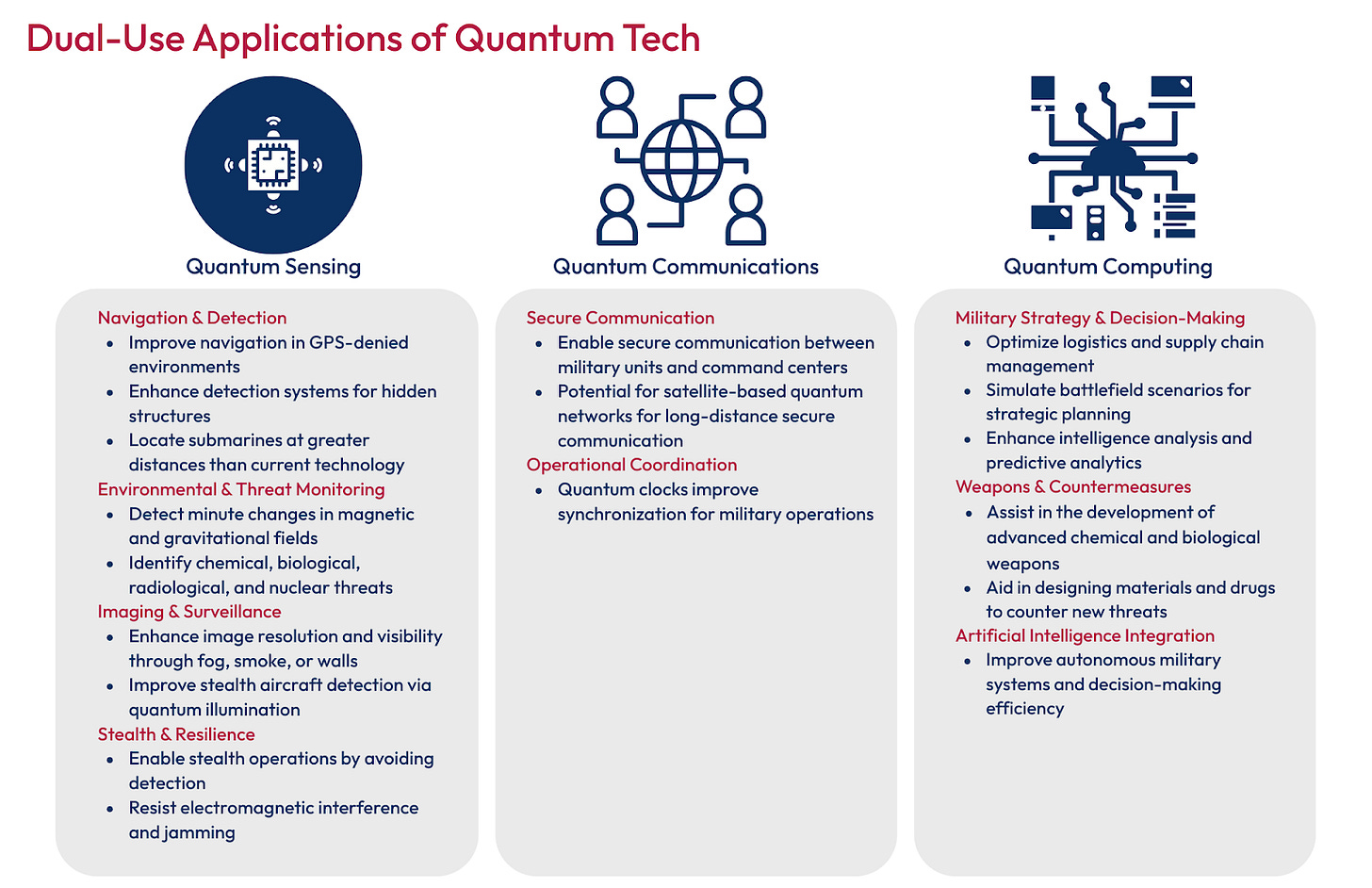Hello, I’m Ylli Bajraktari, CEO of the Special Competitive Studies Project. In this edition of our newsletter, SCSP’s Olivia Armstrong, Associate Director for Future Technology Platforms, takes a look at Boulder, Colorado’s role in securing America’s quantum future. As the United States competes globally in quantum technology, understanding and strengthening regional quantum pipelines are critical to maintaining our national security and technological leadership.
Today, as we celebrate World Quantum Day, we aim to shine a spotlight on the remarkable quantum innovation happening across America. This global observance is dedicated to promoting broader awareness and understanding of quantum science and technology, giving us the perfect opportunity to explore one of our nation's quantum success stories. Our attention turns to our recent visit to Denver and nearby Boulder, Colorado—a remarkable nexus of quantum innovation that has quietly become one of America's most strategic technological assets.
During our visit to University of Colorado (CU) Boulder, we witnessed firsthand the unique ecosystem that has transformed this college town into a quantum powerhouse.
The Beginnings of a Quantum Hub
The roots of Boulder's quantum ecosystem reach back to a pivotal moment in 1951 when the Boulder Chamber orchestrated a remarkable community effort, bringing together community members to purchase land specifically to attract federal research investment. This land, donated to the federal government, became the site of the National Institute of Standards and Technology (NIST) Boulder campus—a decision that would transform the region's technological trajectory for decades to come.
This early investment has blossomed into an extraordinary concentration of federal and state funded research entities. Boulder now boasts one of the highest concentrations of federally funded research entities in the country. Within Colorado alone, there’s approximately 30 federally funded labs that conduct cutting-edge research, creating a critical mass of scientific exploration that few regions can match.
The quantum story in Boulder gained particular momentum when NIST’s atomic clock research was relocated to Colorado in 1954, establishing a foundation for quantum innovation that would flourish for decades. This relocation of critical quantum research laid the groundwork for what would become a world-class quantum ecosystem.
What makes Boulder's federal research presence particularly conducive to innovation is NIST’s often "smaller science" approach, contrasting with the "big science" models featuring the likes of major particle accelerators seen in other regions. The atomic clock research that flourished at NIST proved inherently translatable to commercial applications and more approachable for startups. This accessibility to quantum science created fertile ground for commercial applications to emerge.
Boulder’s ecosystem was further changed through the formation of JILA, formerly known as the Joint Institute for Laboratory Astrophysics. It is a partnership between CU Boulder and NIST, and it exemplifies the adaptability that has kept Boulder at the quantum frontier. Originally focused on astrophysics, JILA has reinvented itself to stay at the cutting edge of quantum science. This willingness to evolve has enabled Boulder's federal labs to remain at the forefront despite the rapidly changing quantum landscape.
Convergence of Boulder’s Quantum Stakeholders
The journey from laboratory research to commercial quantum technology can be illustrated by the story of one of the Boulder area’s quantum technology companies, Infleqtion (formerly ColdQuanta). This company entered the quantum space around 2007— a time when the field was still in its infancy. As global investment and scientific interest in quantum information science (QIS) have surged, Infleqtion has experienced strong growth and diversified its quantum product portfolio. Its trajectory reflects both the patience required to cultivate quantum technologies and the accelerating pace of the industry’s maturation. .
Today, Boulder's quantum leadership has positioned it within a growing global landscape of approximately 800 quantum companies worldwide, with about 54+ quantum companies operating in the Denver-Boulder area alone. What distinguishes the region’s approach is the unity of its ecosystem: innovations spun-off from federal labs, world-class know-how, experimentation, talent development from NIST and CU Boulder, and a thriving commercial sector to receive these advantages. This transfer of technology across this Boulder-specific innovation triad represents a crucial pipeline for transforming research into economic and national security advantages.
FormFactor is another example of this innovation triad. This California-based provider has an office in Boulder and develops testing and measurement technologies for the semiconductor industry. It acquired the Boulder-based High Precision Devices (HPD) that exemplifies this innovation pathway. HPD was founded by an NIST engineer who developed expertise in cryogenics in the early 2000s. FormFactor and HPD ' focused on developing the cryogenic wafer prober—technology critical for testing quantum components. Boulder's quantum innovations continue to attract established technology firms looking to position themselves in the quantum future.
The ecosystem’s scale is evident in the global and national companies that have chosen the Denver-Boulder region for their quantum operations. Quantinuum, one of the largest independent quantum computing companies, calls Broomfield their global home. Vescent Technologies, based in Golden, supplies a significant portion of the U.S.-based critical photonic components for the quantum supply chain. In Denver, Maybell—a dilution refrigeration startup—is looking to expand the frontier of quantum cooling innovation. What began in Boulder has evolved into a regional powerhouse for quantum innovation, with impact that stretches well beyond city limits.
Dual-Use Applications of Quantum Technologies
What makes Boulder's innovation pipeline particularly valuable for national security is the inherently dual-use nature of quantum technologies. The same quantum sensors that might detect underground structures for commercial applications can enhance military situational awareness. Quantum computing algorithms designed to can be repurposed to develop next-generation stealth materials for defense. Quantum communications systems that secure financial transactions can protect classified information. This dual-use characteristic creates natural synergies between commercial innovation and national security applications, allowing advances in either domain to strengthen the other.
NIST and CU Boulder play a crucial role in this pipeline, having nurtured approximately 30 quantum-focused companies. The university maintains a dual focus towards quantum development —advancing fundamental science while facilitating practical applications—exemplifying the balanced approach that makes Boulder's quantum ecosystem so innovative.

Harnessing Regional Resources for Quantum Innovation
What truly sets this ecosystem apart is not just the presence of individual research labs, universities, or companies, but the distinctive collaborative spirit that binds them together. The ecosystem operates on an ethos of "give first"—a philosophy where participants contribute to the collective strength of the ecosystem rather than individual, immediate interests. This collaborative mindset has created an environment where innovations and resources are shared in ways that strengthen the entire quantum community while accelerating innovation & commercialization.
This collaboration is not merely philosophical—it's practical. Rather than relying on large-scale funding alone, stakeholders in Colorado have consistently maximized impact through creative partnerships and efficient resource allocation. This culture of strategic collaboration has allowed the region to punch above its weight and compete with more heavily funded areas. The launch of Elevate Quantum, an EDA Tech Hub that spans the Mountain West Regions of Colorado, New Mexico, and Wyoming, exemplifies this collaborative approach. This public-private collaboration mobilized resources and expertise from across sectors to position Colorado for success in the national quantum ecosystem.
Boulder's quantum success combines intentional strategy with organic growth. This balance between strategic planning and natural ecosystem development has created a sustainable model that continues to evolve. Even small but strategic investments further illustrate Colorado's approach. Modest state-led grants of around $50,000 provide crucial early support for emerging innovators. This tiered support system ensures that promising ideas can advance through various stages of development without falling into the "valley of death" that often prevents commercialization.
The integration of quantum research with Colorado's diverse technical sectors creates additional synergies crucial for national security applications. The region's expertise across multiple domains—particularly in aerospace and physics—provides both an established physics and engineering foundation for quantum technologies and specialized knowledge that helps translate academic breakthroughs into practical capabilities in a healthy commercial ecosystem. This cross-fertilization accelerates the path from laboratory discoveries to deployed systems that strengthen the ecosystem.

Beyond Boulder
While Boulder's quantum ecosystem represents a remarkable success story, maintaining America's quantum advantage requires a nationwide approach. Other regions developing significant quantum capabilities include Chattanooga, Tennessee, with its focus on quantum communications in collaboration with Oak Ridge National Laboratory, and the Chicago ecosystem, where they leverage Argonne National Laboratory to help build quantum capacity within the area.
A vision is emerging that extends beyond regional competition—the integration of these regional ecosystems to increase America's overall competitiveness. The potential for multi-state convenings and collaborations, regardless of funding sources, represents a strategic approach to quantum development that could maximize America's collective capabilities.
The Quantum Economic Development Consortium (QED-C) offers one vehicle for this national integration. Such cross-regional collaboration addresses a critical national security concern: ensuring that America's quantum capabilities develop comprehensively rather than in isolated pockets. Each quantum hub brings distinct strengths—Boulder's expertise in quantum sensing and computing, Tennessee's focus on quantum communications, and emerging capabilities in other regions—that together provide the full spectrum of quantum technologies needed to strengthen the United States’s QIS capabilities.

While Boulder's quantum ecosystem is internationally recognized through institutions like JILA and NIST, it faces significant competition from well-funded quantum initiatives in other countries, like China. A networked national approach, taking inspiration from Colorado’s success and stemming from these regional hubs, would strengthen America's position in this global quantum race, ensuring that regional innovations contribute to a cohesive national capability.
Scaling Regional Success into National Strength
Boulder's experience offers valuable lessons for emerging quantum hubs. The active cross-pollination occurring as representatives from other states’ quantum ecosystems visit Colorado to learn from its approach demonstrates how knowledge sharing can accelerate development across regions. As these connections strengthen, America's overall quantum ecosystem becomes more resilient and innovative.
This regional integration work complements and enhances the broader framework established by the National Quantum Initiative (NQI), which provides crucial federal coordination and investment across the quantum landscape. The NQI's strategic vision—spanning research, education, and technology transfer—provides the national architecture within which regional hubs can flourish. By strengthening connections between regional quantum ecosystems like Colorado’s and the national NQI framework, the United States can further develop a comprehensive quantum strategy that leverages both localized innovation and coordinated national priorities—creating a resilient approach that enhances both economic competitiveness and national security.
Registration is open for the AI+ Expo!
The AI+ Expo is back! Join us on June 2-4, 2025 at the Washington Convention Center as we bring together the brightest minds in artificial intelligence, policy, and industry. This is your chance to explore the latest advancements, hear discussions on topics such as energy, robotics, biotech, compute, fintech and cryptocurrency, connectivity, AR/VR, aerospace, and defense and how they will shape the future of AI. This is an event you won't want to miss with over 15,000 attendees, 300 speakers, 36 demonstrations and so much more.
SCSP has taken over the DMV on WMATA buses and Metro cars! If you see an AI+ Expo bus, take a photo and post it on social media and tag SCSP and use #SCSPSpotted. Those who do will receive a giveaway at the event!






